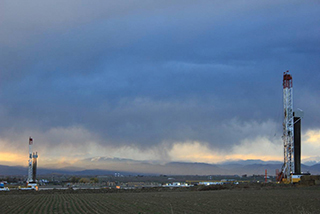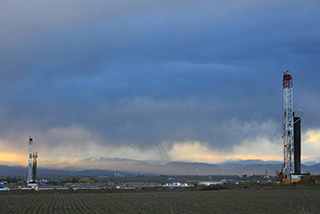Drilling down for common ground
Fracking task force issues first recommendation
Allen Best //July 1, 2015//


Drilling down for common ground
Fracking task force issues first recommendation
Allen Best //July 1, 2015//

It looked ugly a year ago as protagonists in Colorado’s messy dispute about oil-and-gas drilling girded for an election season of 15-second, finger-pointing sound bytes. A handful of cities along Colorado’s northern Front Range had already insisted on their right to control drilling in their jurisdictions, and a coalition led by U.S. Rep. Jared Polis proposed to revise the state constitution to further give local governments supremacy over regulation — a shift hotly disputed by oil and gas companies and state government.
At the eleventh hour, Gov. John Hickenlooper announced a truce. Central to the cease-fire was his appointment of a diverse, 19-member task force. Since then, the shouting and anguish have subsided. Is that proof of the success of the task force’s nine recommendations issued in February, or merely a consequence of reduced drilling activity in northern Colorado?
Two former governors, Roy Romer, a Democrat, and Bill Owens, a Republican, argue for success. The recommendations, says Romer in a press release, “will make one of the best regulatory systems in the country even better.”
Also arguing for success is task force member Bernie Buescher. A former Democratic state legislator from Grand Junction and secretary of state from 2009 to 2011, Buescher says he believes the more thoughtful planning process identified by the task force can eliminate a “fairly high percentage” of conflicts.
Buescher, sitting in the hearings from Loveland to Durango, was impressed by the diversity of drilling in Colorado. The nature of drilling around Rifle, Durango and Greeley are very different, he says. “When people say that one size does not fit all, that really applies.”
Already, several task force recommendations have been executed. Government oversight of the state’s 50,000 active wells was a sore spot, and staffing by the Colorado Oil and Gas Conservation Commission was thin. In response, state legislators this year allocated $1.4 million to pay for 12 new employees. Another $361,000 was allocated to create a hot line and website for information and a forum for raising concerns about operations. And $403,000 has been allocated to create a mobile air-monitoring unit. Next winter, legislators will address the recommendation to conduct a health risk assessment.
Local influence
Still unresolved is how exactly to give local jurisdictions a greater voice in oversight without relinquishing state authority. Drillers have feared that some local governments will just say no – effectively nullifying the private property of subsurface mineral estates. The recommendations from the task force about how to share oversight with local regulators are to be taken up by the Colorado Oil and Gas Conservation Commission. As of May 22, no schedule had been set.
Task-force member Matt Sura, a lawyer who works with a variety of landowners, homeowner groups and conservation organizations, contends recommendations did not go nearly far enough. Even in the case of hard-rock mining, local governments play the trump card in land-use decisions, he points out. Only in the case of oil and gas drilling does the state trump local authority.
Colorado’s rules allow close proximity to schools and homes. In Greeley, one drilling rig was 450 feet from elementary school playgrounds. Another approved operation was 350 feet from a low-income residential apartment complex.
The most significant issue facing the Colorado Oil and Gas Conservation Commission, Sura says, is defining what constitutes “large-scale oil and gas facilities,” creating a new set of regulations around those larger facilities, and making sure local governments have a meaningful rule in siting the operations. The commission, he adds, “has an opportunity, and I believe an obligation, to address some of the legitimate concerns and grievances of local governments.”
Has Hickenlooper’s task force averted a spitball fight at the 2016 election?
Member Rebecca Kourlis, a former Colorado Supreme Court justice, says she’s unsure. She describes the task force recommendations as “small steps forward” that nonetheless fall short. “None of the recommendations really untangle the primary issue of state versus local involvement in the decision-making. And, none of the recommendations were truly visionary,” says Kourlis, who now has a base in Moffat County while directing the Denver-based Institute for the Advancement of the American Legal System.
“Whether the goodwill and the small steps forward will be enough to defuse a possible initiative is beyond my powers of prediction,” she says. “In the Hippocratic sense, we did no harm. But, did we do enough good to chart a collaborative path forward? I don’t know.”
The process itself was flawed, she believes. Colorado’s open-meeting laws precluded informal discussions between task force members outside of meetings, limiting consensus-building and real, in-depth discussion. Also, the learning curve was steep. “We only had a couple of meetings in which we really drilled down into the conversations about solutions – and we did it in a full open-meeting format,” Kourlis says.
Kourlis also believes many on the task force felt allegiances to their constituencies, “and were not free to synergize toward out-of-the box solutions. It would have been much more productive if we would have been able to kick around some crazy ideas, or some non-starters, in order to arrive at good ideas,” she says. “I actually think that if the process had been structured differently, the group might have come together in some surprising and creative ways.” cb
Price decline hits rigs, workers
The night sky in Colorado has darkened a bit. A year ago in late May, there were 66 drilling rigs standing, searching for oil and natural gas in around-the-clock operations, their lights illuminating the countryside in the Denver-Julesberg Basin and elsewhere like amusement park rides. This year in May there were 39.
As each drilling rig employs about 110 people, the slowed activity suggests reduced employment of at least 2,750, but probably more. Nobody specifically tracks employment in the sector.
But the impact to Colorado’s economy may be much greater than that. The Denver Post in March reported that the nine major drillers operating along the Front Range slashed their spending in 2015 by 30 percent, or about $2 billion.
Plummeting oil prices last year and continued low prices for natural gas explain the slowdown. In June 2015, oil was up to $107 per barrel. In March, it hit a low of $42 per barrel. Natural gas, meanwhile, remains at about $2.50 per million Btu, compared to a high of about $14 before the Great Recession.
Encana, the state’s third largest driller, has shifted most new drilling to four fields, two in Canada and two in Texas, where margins remain good, says Doug Hock, a spokesman in the company’s Denver office.
The D-J Basin, which produces primarily oil with natural gas as a secondary product, currently has the most activity among the state’s four major oil and gas fields. Hock says Encana still sees its holdings there as a good assets – once prices edge upward. “We don’t see oil staying at $50, but we probably won’t go back to $100. The equilibrium is somewhere in the middle,” he says.
The Piceance Basin, located in the Rifle area, produces primarily natural gas. Encana has quit drilling there altogether – for now. But it still operates 3,800 wells there. “That provides us with cash flow,” says Hock.

























